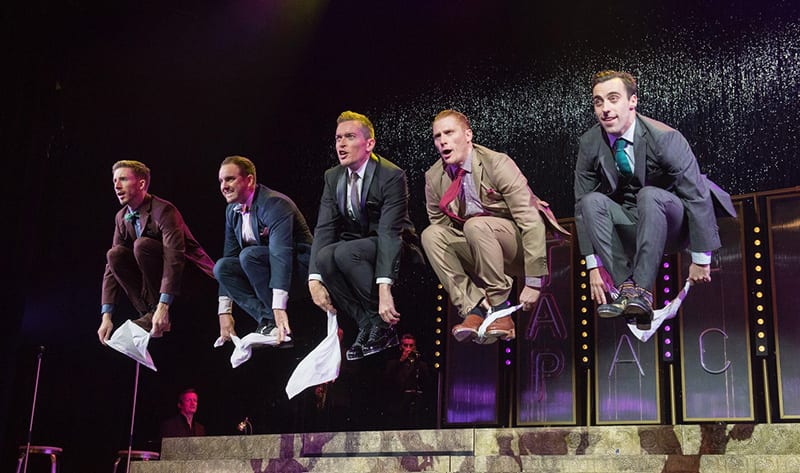The Tap Pack is a well-established Australian touring group of exceptional tap dancers – precise, balletic and athletic – who also are no mean singers. Between them they cover the gamut of tap styles from improvisation through to the most stylised routines of ‘Broadway Tap’, and for anyone new to the myriad delights of tap this show is a perfect introduction, much more so than – say – 42nd Street. Their individuality is built around a fusion between peerless technical facility and the joshing elegant, devil-may-care camaraderie of the Sinatra-Davis-Martin Rat Pack groove that has spawned its own successful tribute-show tradition.
Tap can and does have a mesmeric effect, especially when unaccompanied. Whether with fifty or five people on stage it should have an overwhelming, thrilling, percussive impact, but there is scope too for the kinds of balletic and ballroom inspired sequences pioneered by Fred Astaire and Gene Kelly, where the overall shapes matter as much as the tap patterns. Going deeper still it can offer intimacy and suggestiveness too: time can seem almost suspended as the dancer, like a soloist in an instrumental concerto, draws the audience in rather than bludgeoning them into submission. The high point of the evening was undoubtedly the extended solo by Tommy Egan where the moves are influenced by jazz improvisation and moved from slow sensual suggestion through to incredible kinetic virtuosity as both feet kicked up a storm but in wholly contrasting rhythmic sequences.
Different percussive sound effects were on display as well thanks to the use of different shoes and a variety of shapes of metal tap – sometimes a precise and focused sound, sometimes a duller, warmer, and more recessed experience altogether. At its best this show allows you to feel fully engrossed and imaginatively stimulated with your eyes open or closed. This was ably assisted on the production side by an impressively flexible set from Justin Nardella, which gave us the standard bar and panelled backdrop, but also cleverly disassembled into as many sets of stairs and combinations thereof as the dancers needed to strut their stuff. Likewise the four-piece band, led from the drums by Micky Bister, gave warm and tight rhythmic support and made the most of its solo riffs.
Where the show was less successful was in its dramatic continuity. The second half was much more successful than the first in integrating the individual talents of the performers with the overall tone and style and shtick of the Rat Pack: the swagger and competitiveness of that ethos came over well in a rivalrous song competition between classic and modern numbers which showcased Sean Mulligan and Ben Brown’s singing excellently. Jesse Rasmussen’s skills as an imitator of Davis, Kelly and Astaire won him deserved applause, and the concerted numbers emerged naturally out of the friendly rivalry of the performers. In contrast, the first half just seemed no more than the sum of its individually striking parts, rather than a sequence which flowed with natural and inevitable continuity. A stronger directorial hand is surely needed here.
Among the other numbers to watch for is a brilliantly minimalist encapsulation of the machismo of the Western, with only the feet visible and a blast of Ennio Morricone to signal where we are. There is also a hugely unexpected and imaginative reinvention of Wonderwall, and a sequence of delightful engagements between Rasmussen and the audience using a Cajon box to break down the fourth wall. Max Patterson gave us a lively flavour of tap as street-art to round out their survey. To some extent this sheer variety compensated for the trite, flat and creaky dialogue, which makes the mistake of repeating the sexism of the Rat Pack era without redeeming it with the kind of improvisatory verbal wit needed to match the flair and invention everywhere else in the show.
With a little re-packaging as the tour proceeds this show could easily garner the five-star rating that the core skills of its performers essentially merit. These performers should just trust to their evident ability to connect naturally and spontaneously with an audience that is already very much on their side.

